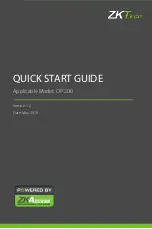
BLUEBOX CX Industrial UHF
Page 30 of 126
3
Operating Features
In ‘continuous’ mode the
BLUEBOX
is characterized by the coexistence of 2
‘parallel’ and asynchronous activities: the tag identification (inventory) and the
communication with the ‘host’ system. The ‘continuous’ identification activity
interacts with the communication activity through a buffer that contains the code
of the last identified tags or that is empty indicating the absence of tags. Due to
synchronization and filtering reasons, the buffer is handled for each identified
tag by a parameter defined as ‘hold time’ (same as ‘filter time’
defined below,
to be set in the ra
nge of 0 … 99 seconds or 0 ... 99 minutes, default value 1
second) and allows to extend ‘artificially’ the presence of the tag after it leaves
the antenna’s influence area; this behavior is observable looking at the yellow
led status that is ‘on’ indicatin
g the presence of tags and also through the
activation of the relay nr 1 (if its ‘automatic’ management is enabled by the flag
defined in the general parameters). Through the command ‘data request’ it is
possible to get the data contained in the buffer.
The
BLUEBOX
handles also a 100 elements FIFO queue which is combined with
the ‘filter time’ general parameter (to be set in a range of 0 … 99 seconds or 0
... 99 minutes, default value 1 second) that prevents the queue saturation in
case of a tag ‘continuous’ presence
and a 1024 records in non volatile memory.
The records stored in non volatile memory, like every other data stored in non
volatile memory, are kept in memory even during a power off condition. The
erase of the records is made by the communication software after the acquisition
using an explicit command. After the erase command the records are not
immediately removed from the
BLUEBOX
memory, but they will be overwritten
with new records. For this reason, after the acquisition of the records, the
BLUEBOX
is ready to record its maximum number of records or to read again
the acquired data (using special protocol commands). The records are stored in
memory with the following data format.
Byte 0
Byte 1 … 7
Byte 8
Byte 9 … 126
Byte 127
Reserved
Timestamp
Tag’s ID Length
Tag’s ID
CRC
Where:
Timestamp
The detection timestamp. BCD coded with the following
format yyyyMMddhhmmss. In case of no RTC or RTC error
this field is filled with 0xFF bytes.
Tag’s ID Length
The size of the tag’s ID in bytes.
Tag’s I
D
The ID of the tag in the format
<type> <ID> <RSSI> <antenna> <direction>
where:
















































